The Intel Haswell-E CPU Review: Core i7-5960X, i7-5930K and i7-5820K Tested
by Ian Cutress on August 29, 2014 12:00 PM ESTCPU Benchmarks
The dynamics of CPU Turbo modes, with both Intel and AMD, can cause concern during environments with a variable threaded workload. There is also an added issue of the motherboard remaining consistent, depending on how the motherboard manufacturer wants to add in their own boosting technologies over the ones that the CPU manufacturer would prefer they used. In order to remain consistent, we implement an OS-level unique high performance mode on all the CPUs we test which should override any motherboard manufacturer performance mode.
HandBrake v0.9.9: link
For HandBrake, we take two videos (a 2h20 640x266 DVD rip and a 10min double UHD 3840x4320 animation short) and convert them to x264 format in an MP4 container. Results are given in terms of the frames per second processed, and HandBrake uses as many threads as possible.
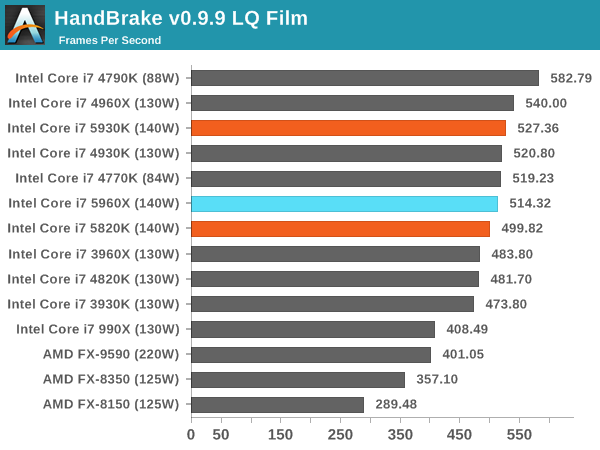
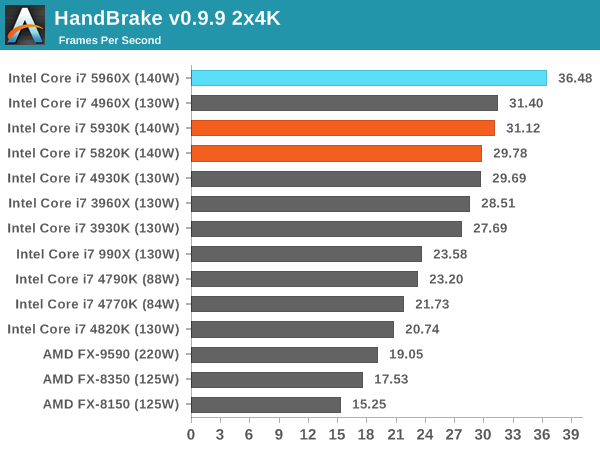
The variable turbo speeds of the CPUs results in a small difference in low quality conversion, and the high single core frequency of the 4790K wins there. For 4K conversion the problem becomes more parallel and the extra cores of the 5960X push it ahead of the pack. The 5930K and 5820K are both behind the 4960X however.
Agisoft Photoscan – 2D to 3D Image Manipulation: link
Agisoft Photoscan creates 3D models from 2D images, a process which is very computationally expensive. The algorithm is split into four distinct phases, and different phases of the model reconstruction require either fast memory, fast IPC, more cores, or even OpenCL compute devices to hand. Agisoft supplied us with a special version of the software to script the process, where we take 50 images of a stately home and convert it into a medium quality model. This benchmark typically takes around 15-20 minutes on a high end PC on the CPU alone, with GPUs reducing the time.
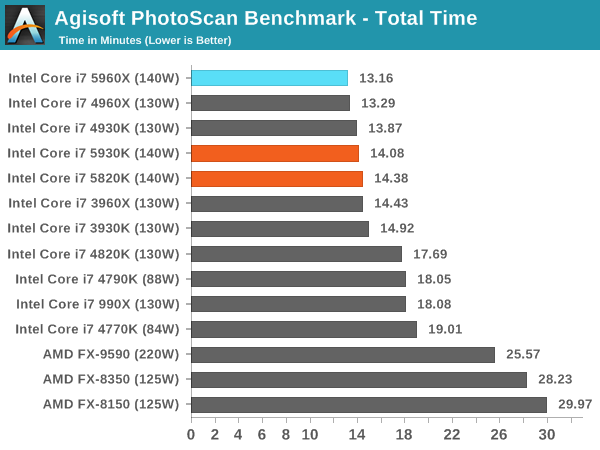
Photoscan's four separate components rely on different amounts of high frequency vs. many cores: check our Bench database for more detailed results but overall the 5960X comes out on top. That being said, the 5820K is less than 40% of the price and is only 1.2 minutes behind.
Dolphin Benchmark: link
Many emulators are often bound by single thread CPU performance, and general reports tended to suggest that Haswell provided a significant boost to emulator performance. This benchmark runs a Wii program that raytraces a complex 3D scene inside the Dolphin Wii emulator. Performance on this benchmark is a good proxy of the speed of Dolphin CPU emulation, which is an intensive single core task using most aspects of a CPU. Results are given in minutes, where the Wii itself scores 17.53 minutes.
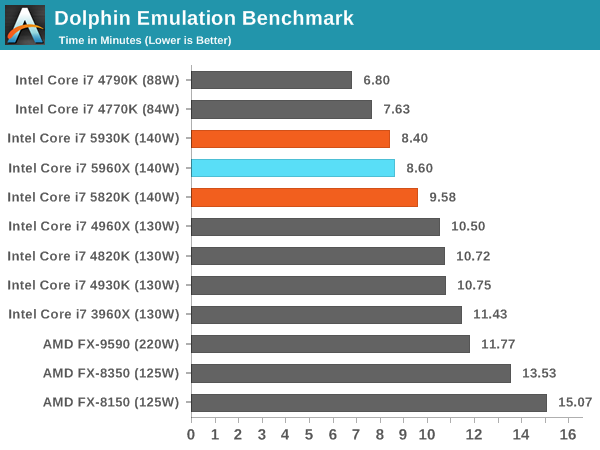
Dolphon loves single core speed and efficiency, meaning the 4790K wins out again. Interestingly the large L3 cache of the 5960X also helps here against the 5820K, despite the 5820K having a higher single thread frequency.
WinRAR 5.0.1: link
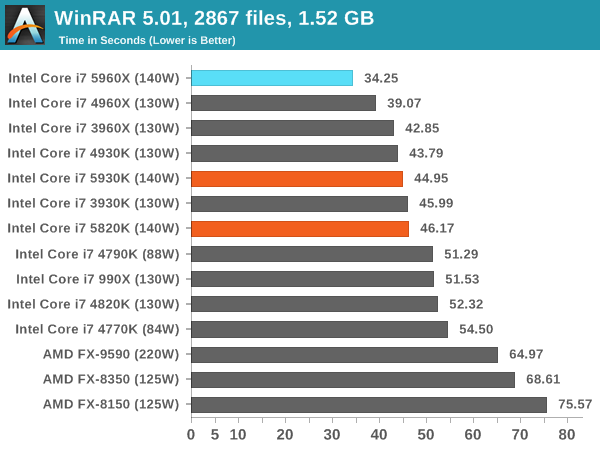
WinRAR is a variable thread workload, but more cores still wins out. Interestingly the xx60X CPUs are ahead of the xx30K CPUs followed by the xx20K. After this comes the 4790K, and then the 990X on par, showing how far three generations of Intel CPU have developed.
PCMark8 v2 OpenCL
A new addition to our CPU testing suite is PCMark8 v2, where we test the Work 2.0 and Creative 3.0 suites in OpenCL mode.
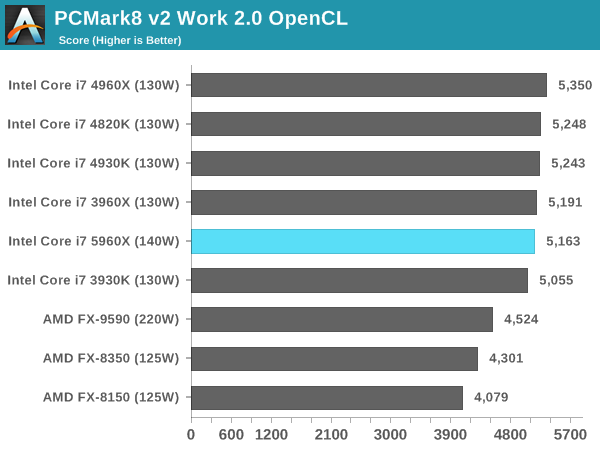
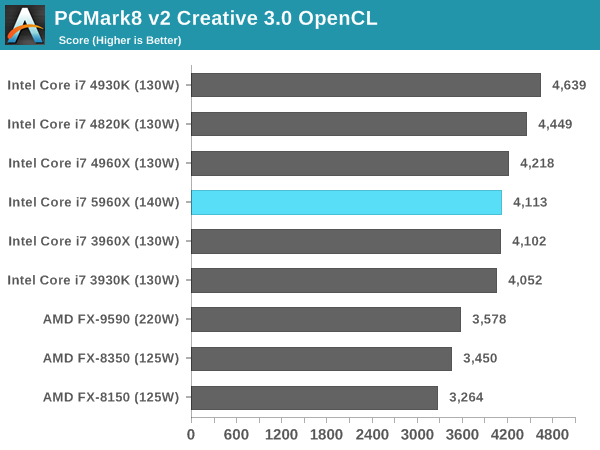
PCMark v8 relies on a number of factors, and it would seem that frequency is preferred over cache and memory. Interestingly the 4930K beat the 4960X in the Creative Suite with no obvious explanation.
Hybrid x265: link
Hybrid is a new benchmark, where we take a 4K 1500 frame video and convert it into an x265 format without audio. Results are given in frames per second.

Converting 4K video gets another step in the preference for more cores in Hybrid x265. The 5820K matches the 3960X, showing the progression of CPU generational development.
Cinebench R15
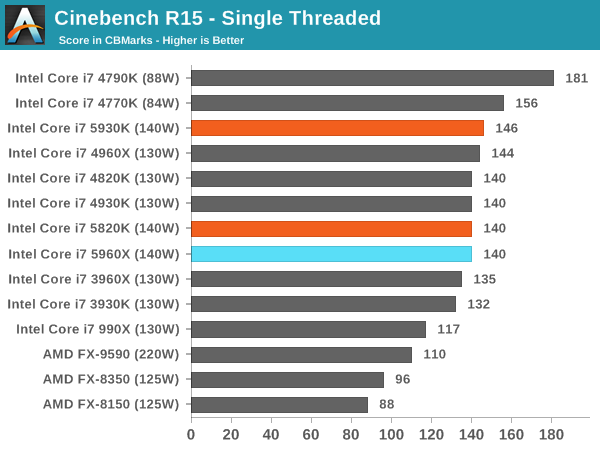
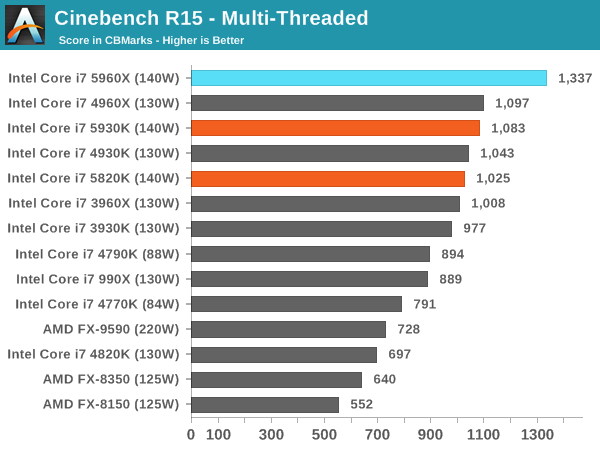
3D Particle Movement
3DPM is a self-penned benchmark, taking basic 3D movement algorithms used in Brownian Motion simulations and testing them for speed. High floating point performance, MHz and IPC wins in the single thread version, whereas the multithread version has to handle the threads and loves more cores.
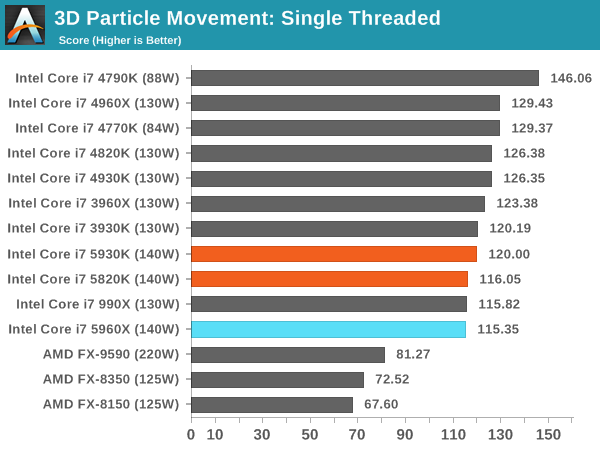

FastStone Image Viewer 4.9
FastStone is the program I use to perform quick or bulk actions on images, such as resizing, adjusting for color and cropping. In our test we take a series of 170 images in various sizes and formats and convert them all into 640x480 .gif files, maintaining the aspect ratio. FastStone does not use multithreading for this test, and results are given in seconds.
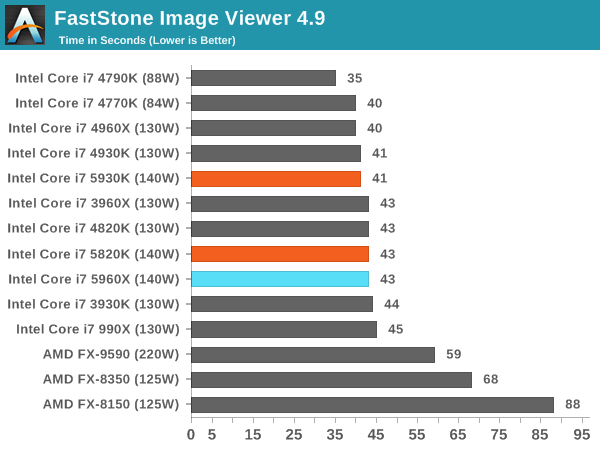
FastStone is a purely single threaded exercise, showing here how the lower core CPUs with high turbo perfom best, and by quite a margin.










203 Comments
View All Comments
schmak01 - Friday, January 16, 2015 - link
I thought the same thing, but it probably depends on the game. I got the MSI XPower AC X99s Board with the 5930K. when I was running a 2500k at 4.5 Ghz for years. I play a lot of FFXIV which is DX9 and therefore CPU strapped. I noticed a marked improvement. Its a multithreaded game so that helps, but on my trusty sandy bridge I was always at 100% across all cores while playing, now its rarely above 15-20%. Areas where Ethernet traffic picks up, high population areas, show a much better improvement as I am not running out of CPU cycles. Lastly Turnbased games like GalCivIII and Civ5 on absurdly large Maps/AI's run much faster. Loading an old game on Civ5 where turns took 3-4 minutes now take a few seconds.There is also the fact that when Broadwell-E's are out in 2016 they will still use the LGA 2011-3 socket and X99 chipset, I figured it was a good time to upgrade for 'future proofing' my box for a while.
Flunk - Friday, August 29, 2014 - link
Right, for rendering, video encoding, server applications and only if there is no GPU-accelerated version for the task at hand. You have to admit that embarrassingly parallel workloads are both rare and quite often better off handed to the GPU.Also, you're neglecting overclocking. If you take that into account the lowest-end Haswell-E only has a 20%-30% advantage. Also, I'm not sure about you but I normally use Xeons for my servers.
Haswell-E has a point, but it's extremely niche and dare I say extremely overpriced? 8-core at $600 would be a little more palatable to me, especially with these low clocks and uninspiring single thread performance.
wireframed - Friday, August 29, 2014 - link
The 5960X is half the price of the equivalent Xeon. Sure if you're budget is unlimited, 1k or 2k per CPU doesn't matter, but how often is that realistic.For content creation, CPU performance is still very much relevant. GPU acceleration just isn't up to scratch in many areas. Too little RAM, not flexible enough. When you're waiting days or weeks for renderings, every bit counts.
CaedenV - Friday, August 29, 2014 - link
improvements are relative. For gaming... not so much. Most games still only use 4 core (or less!), and rely more on the clock rate and GPU rather than specific CPU technologies and advantages, so having a newer 8 core really does not bring much more to the table to most games compared to an older quad core... and those sandy bridge parts could OC to the moon, even my locked part hits 4.2GHz without throwing a fuss.Even for things like HD video editing, basic 3D content creation, etc. you are looking at minor improvements that are never going to be noticed by the end user. Move into 4K editing, and larger 3D work... then you see substantial improvements moving to these new chips... but then again you should probably be on a dual Xeon setup for those kinds of high-end workloads. These chips are for gamers with too much money (a class that I hope to join some day!), or professionals trying to pinch a few pennies... they simply are not practical in their benefits for either camp.
ArtShapiro - Friday, August 29, 2014 - link
Same here. I think the cost of operation is of concern in these days of escalating energy rates. I run the 2500K in a little Antec MITX case with something like a 150 or 160 watt inbuilt power supply. It idles in the low 20s, if I recall, meaning I can leave it on all day without California needing to build more nuclear power plants. I can only cringe at talk about 1500 watt power supplies.wireframed - Friday, August 29, 2014 - link
Performance per watt is what's important. If the CPU is twice as fast, and uses 60% more power! you still come out ahead. The idle draw is actually pretty good for the Haswell-E. It's only when you start overclocking it gets really crazy.DDR4's main selling point is reduced power draw, so that helps as well.
actionjksn - Saturday, August 30, 2014 - link
If you have a 1500 watt power supply, it doesn't mean you're actually using 1500 watts. It will only put out what the system demands at whatever workload you're putting on it at the time. If you replaced your system with one of these big new ones, your monthly bill might go up 5 to 8 dollars per month if you are a pretty heavy user, and you're really hammering that system frequently and hard. The only exception I can think of would be if you were mining Bit Coin 24/7 or something like that. Even then it would be your graphics cards that would be hitting you hard on the electric bill. It may be a little higher in California since you guys get overcharged for pretty much everything.Flashman024 - Friday, May 8, 2015 - link
Just out of curiosity, what do you pay for electricity? Because I pay less here than I did when I lived in IA. We're at .10 KWh to .16 KWh (Tier 3 based on 1000KWh+ usage). Heard these tired blanket statements before we moved, and were pleased to find out it's mostly BS.CaedenV - Friday, August 29, 2014 - link
Agreed, my little i7 2600 still keeps up just fine, and I am not really tempted to upgrade my system yet... maybe a new GPU, but the system itself is still just fine.Let's see some more focus on better single-thread performance, refine DDR4 support a bit more, give PCIe HDDs a chance to catch on, then I will look into upgrading. Still, this is the first real step forward on the CPU side that we have seen in a good long time, and I am really excited to finally see some Intel consumer 8 core parts hit the market.
twtech - Friday, August 29, 2014 - link
The overclocking results are definitely a positive relative to the last generation, but really the pull-the-trigger point for me would have been the 5930K coming with 8 cores.It looks like I'll be waiting another generation as well. I'm currently running an OCed 3930K, and given the cost of this platform, the performance increase for the cost just doesn't justify the upgrade.